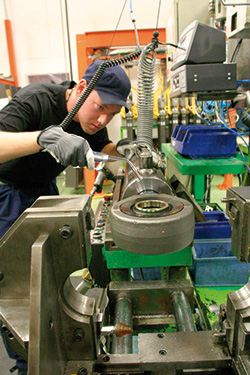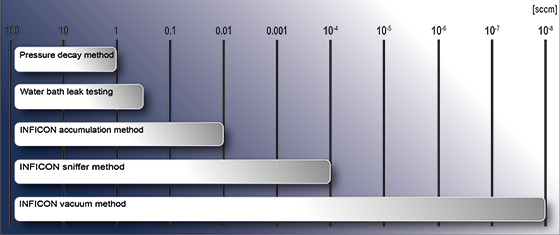Nine Good Reasons to Test for Leaks with Tracer Gas

Leak testing heavy duty hydraulic cylinders with tracer gas
Products designed to contain fluid or gas often need leak testing to ensure their integrity. Enclosures designed to protect the content from ingress (for example electronics) also need to be leak tight. Testing for leaks can be a time-consuming, messy and even dangerous procedure. Several different methods are available. Traditional methods work on the principle of creating a difference in pressure between the inside and the outside of the enclosure, for instance by filling the component with air or gas, or submerging it in water. The product is then observed to see if it leaks, or alternatively pressure is monitored.
Traditional methods are popular since they are in most cases easy to apply, and a fairly moderate financial investment. But there may also be many disadvantages, such as – they are labor intensive, the wet product has to be dried, the risk of the tested object breaking apart under pressure and, above all, potentially inaccurate and not quantitative test results. But, most importantly– they may not be sensitive enough to find the leaks you need to find.
A more direct approach to finding leaks is to follow the flow of a tracer gas as it passes through, and possibly escapes, the product. Tracer gas quickly identifies the exact detail that you are looking for - the hole in the wall of the structure.
Moving from conventional to tracer gas leak testing brings major benefits in a number of areas:
1. Product functionality
For many modern products, isolation from atmospheric pressure is essential. A modern car, for example, can be disabled with just the prick of a pin, if you know where to place it. Tolerances are becoming more exacting and with traditional methods, it can be difficult to identify a leak in the time available or even at all as specifications become increasingly tighter. Many systems also contain electronic components that would be destroyed by water submersion.
2. Product safety
Higher standards for health and safety require that vessels intended to contain harmful substances in the form of liquids, powders and gases, stay leak-free. This is an increasing concern as many substances that were previously considered harmless are now known and need to be treated as harmful.
3. Environmental protection
New regulations for gases harmful to the environment, strict limits on vehicle emissions and increasing requirements for energy efficiency are just some of the driving forces for more demanding environmental legislation. Many companies also have their own environmental policies that make efficient leak testing a necessity. Waste reduction is an additional driving factor. “Consume less with increased output” means, among other things, that unnecessary leakage must be contained. The poor accuracy of traditional leak testing methods is simply not acceptable when aiming to meet modern standards.
4. New technology
Modern energy systems use hydrogen and biogas in many applications. Systems designed to hold gas are more susceptible to leakage than systems designed for fluids and thus, require more rigorous testing. If hydrogen is used in the final application, such as fuel cells or hydrogen batteries, using hydrogen as tracer gas will simplify the operation. As batteries become increasingly popular as an energy source for vehicles, so does the need for leak free batteries to ensure acceptance of the technology as reliable enough for today’s consumer.
5. New materials
New materials, such as engine parts made of plastic; biodegradable paper replacing plastic; and 3D printed products also drive the need for new methods for leak testing. Many structures with thin walls cannot be successfully pressurized, while submersion in water will often destroy the component. Some new materials can be porous unless adequately treated and this can also be detected with tracer gas.
6. Customer relations
The drawbacks of traditional testing methods can also impact product quality which may not be noticed until it reaches your customer. If you are a supplier of industrial goods, you do not want to run the risk that inadequate leak testing negatively impacts your reputation, or leads to missed contracts. Proving that you are in full control of your product quality can be a major sales argument.
7. Reduced labor costs
Traditional leak testing methods tend to be very labor intensive. High labor costs can be mitigated with increased automation. Modern methods for leak testing are less labor intensive and can more easily be automated.
8. Consistent test results
Traditional leak testing methods are often dependent on the performance of the operator. If the operator has a bad day, an air bubble escaping from the AC unit in the water tank might be missed. This results in reduced quality, something manufacturers the world over are becoming less tolerant of. Consistent test results capturing poor quality should instead be used upstream in production as feedback for improved methods and techniques for enhanced product reliability.
9. Improved productivity
Faster leak testing leads to shorter cycle times. Shorter cycle times mean that more output per square meter of the production plant is used for leak testing and this reduces the manufacturing cost of the product. This is one of the main driving forces for replacing outdated leak testing methods.
If you are considering moving from traditional leak testing to detection with tracer gas, contact one of our experts. They can be reached at reachus@inficon.com

Leak test ranges per leak test method